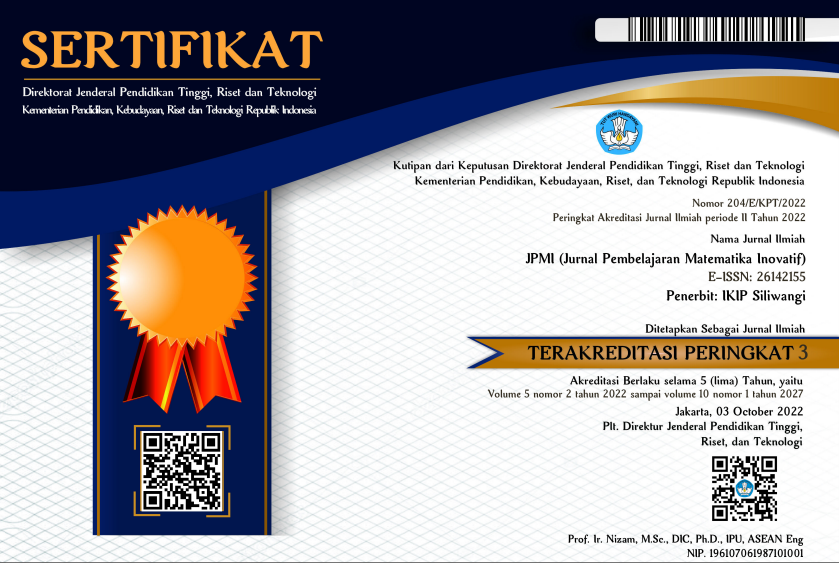ANALISIS BIBLIOMETRIK: FOKUS PENELITIAN CRITICAL THINKING DALAM PEMBELAJARAN MATEMATIKA (2017 – 2022)
DOI:
https://doi.org/10.22460/jpmi.v6i1.14759Keywords:
Critical Thinking, Bibliometrics, Learning MathematicsAbstract
References
Aktoprakac, A., & Hursen, C. (2022). A Bibliometric And Content Analysis of Critical Thinking in Primary Education. Thinking Skills and Creativity, 44. https://doi.org/https://doi.org/10.1016/j.tsc.2022.101029
Bernadetha, N., & Lamhot, N. (2020). The Effectiveness of Problem-Based Learning on Students’ Critical Thinking. Jurnal Dinamika Pendidikan, 13(1), 1–7. https://doi.org/10.33541/jdp.v13i1
Beyer, B. K. (1998). Developing a Scope and Sequence for Thinking Skills Instruction. Educational Leadership, 45(7), 26–30.
Castaño, J. P., Arnal-Pastor, M., Pagán-Castaño, E., & Guijarro-GarcÃa, M. (2022). Bibliometric analysis of the literature on critical thinking: an increasingly important competence for higher education students. Economic Research-Ekonomska Istrazivanja, 35(1), 1–22. https://doi.org/10.1080/1331677X.2022.2125888
Donthu, N., Kumar, S., Mukherjee, D., Pandey, N., & Lim, W. M. (2021). How to conduct a bibliometric analysis: An overview and guidelines. Journal of Business Research, 133(3), 285–296.
Eck, N. J., & Waltman, L. (2017). Citation-based clustering of publications using CitNetExplorer and VOSviewer. Scientometrics, 111(2), 1053–1070.
Eck, N. J. van, & Waltman, L. (2010). Software survey: VOSviewer, a computer program for bibliometric mapping. Scientometrics, 84(2), 523–538.
Fatmawati, A., Zubaidah, S., Mahanal, S., & Sutopo. (2019). Critical Thinking, Creative Thinking, and Learning Achievement: How They are Related. Journal of Physics: Conference Series, 1417(1), 0–9. https://doi.org/10.1088/1742-6596/1417/1/012070
Firmansyah, M. B., Suminar, D. R., & Fardana, N. A. (2021). Tinjauan Literatur Tentang Kepuasan Kerja, Keterikatan Kerja Dan Kinerja Pendidik. Khazanah Pendidikan, 15(2), 181–188. https://doi.org/10.30595/jkp.v15i2.11705
Garfield, E. (2009). From the science of science to Scientometrics visualizing the history of science with HistCite software. Journal of Informetrics, 3(3), 173–179.
Hacioğlu, Y., & Gülhan, F. (2021). The Effects of STEM Education on the 7th Grade Students’ Critical Thinking Skills and STEM Perceptions. Journal of Education in Science, Environment and Health. https://doi.org/10.21891/jeseh.771331
Haeruman, L. D., Rahayu, W., & Ambarwati, L. (2017). Pengaruh Model Discovery Learning Terhadap Peningkatan Kemampuan Berpikir Kritis Matematis Dan Self-Confidence Ditinjau Dari Kemampuan Awal Matematis Siswa Sma Di Bogor Timur. Jurnal Penelitian Dan Pembelajaran Matematika, 10(2), 157–168. https://doi.org/10.30870/jppm.v10i2.2040
Haghparast, M., Hanum, N. F., & Abdullah, N. (2013). Modeling an e-learning tool to cultivate critical thinking in students based on information needs and seeking behavior. Proceedings of 2013 IEEE International Conference on Teaching, Assessment and Learning for Engineering, TALE 2013, August, 521–526. https://doi.org/10.1109/TALE.2013.6654492
Marchy, F., Murni, A., Kartini, & Muhammad, I. (2022). The Effectiveness of Using Problem Based Learning (PBL) in Mathematics Problem Solving Ability for Junior High School Students. AlphaMath Journal of Mathematics Education, 8(2), 185–198. https://doi.org/10.30595/alphamath.v8i2.15047
Marwantika, A. I. (2022). Analisis Bibliometrik Tren Kajian Dakwah Pada Masa Pandemi COVID-19 di Indonesia. Journal of Da’wah, 1(1), 24–41. https://doi.org/10.32939/jd.v1i1.1274
Mayani, I., Suripah, & Muhammad, I. (2022). Analysis of Students’ Errors in Solving Statistical Problems: A Case of 8th Grade Students at SMPN 4 Siak Hulu, Indonesia. Jurnal Pendidikan Mipa, 23(4), 1826–1838.
Muhammad, I., Marchy, F., Do, A., & Naser, M. (2023). Analisis Bibliometrik : Tren Penelitian Etnomatematika dalam Pembelajaran Matematika Di Indonesia ( 2017 – 2022 ). JIPM (Jurnal Ilmiah Pendidikan Matematika) This, 11(2), 267–279.
Muhammad, I., Marchy, F., Rusyid, H. K., & Dasari, D. (2022). Analisis Bibliometrik : Penelitian Augmented Reality Dalam Pendidikan Matematika. JIPM (Jurnal Ilmiah Pendidikan Matematika), 11(1), 141–155. https://doi.org/10.25273/jipm.v11i1.13818
Muhammad, I., & Yolanda, F. (2022). Minat Belajar Siswa Terhadap Penggunaan Software Adobe Flash Cs6 Profesional Sebagai Media Pembelajaran. JIPM (Jurnal Ilmiah Pendidikan Matematika), 11(1), 1–12.
Mutakinati, L., Anwari, I., & Yoshisuke, K. (2018). Analysis of students’ critical thinking skill of middle school through stem education project-based learning. Jurnal Pendidikan IPA Indonesia, 7(1), 54–65. https://doi.org/10.15294/jpii.v7i1.10495
Nuryanti, L., Zubaidah, S., & Diantoro, M. (2021). Analisis Kemampuan Berpikir Kritis Siswa SMK. Jurnal Pendidikan: Teori, Penelitian, Dan Pengembangan, 6(3), 334. https://doi.org/10.17977/jptpp.v6i3.14579
Puig, B., Blanco-Anaya, P., Bargiela, I. M., & Crujeiras-Pérez, B. (2019). A systematic review on critical thinking intervention studies in higher education across professional fields. Studies in Higher Education, 44(5), 860–869. https://doi.org/10.1080/03075079.2019.1586333
Ridwan, M. R., Retnawati, H., Hadi, S., & Jailani, J. (2022). Teachers’ Perceptions in Applying Mathematics Critical Thinking Skills for Middle School Students: A Case of Phenomenology. Anatolian Journal of Education, 7(1), 1–16. https://doi.org/10.29333/aje.2022.711a
Sachdeva, S., & Eggen, P.-O. (2021). Learners’ Critical Thinking About Learning Mathematics. International Electronic Journal of Mathematics Education, 16(3), em0644. https://doi.org/10.29333/iejme/11003
Sidiq, Y., Ishartono, N., Desstya, A., Prayitno, H. J., Anif, S., & Hidayat, M. L. (2021). Improving elementary school students’ critical thinking skill in science through hots-based science questions: A quasi-experimental study. Jurnal Pendidikan IPA Indonesia, 10(3), 378–386. https://doi.org/10.15294/JPII.V10I3.30891
Simatupang, E., & Yuhertiana, I. (2021). Merdeka Belajar Kampus Merdeka terhadap Perubahan Paradigma Pembelajaran pada Pendidikan Tinggi: Sebuah Tinjauan Literatur. Jurnal Bisnis, Manajemen, Dan Ekonomi, 2(2), 30–38. https://doi.org/10.47747/jbme.v2i2.230
Styers, M. L., Van Zandt, P. A., & Hayden, K. L. (2018). Active Learning in Flipped Life Science Courses Promotes Development of Critical Thinking Skills. CBE Life Sciences Education, 17(3), ar39. https://doi.org/10.1187/cbe.16-11-0332
Tanujaya, B., Mumu, J., & Margono, G. (2017). The Relationship between Higher Order Thinking Skills and Academic Performance of Student in Mathematics Instruction. International Education Studies, 10(11), 78. https://doi.org/10.5539/ies.v10n11p78
Thorndahl, K. L., & Stentoft, D. (2020). Thinking critically about critical thinking and prob-lem-based learning in higher education: A scoping review. Interdisciplinary Journal of Problem-Based Learning, 14(1), 1–21. https://doi.org/10.14434/ijpbl.v14i1.28773
Downloads
Published
Issue
Section
License
Copyright (c) 2023 JPMI (Jurnal Pembelajaran Matematika Inovatif)

This work is licensed under a Creative Commons Attribution-ShareAlike 4.0 International License.
The author is responsible for acquiring the permission(s) to reproduce any copyrighted figures, tables, data, or text that are being used in the submitted paper. Authors should note that text quotations of more than 250 words from a published or copyrighted work will require grant of permission from the original publisher to reprint. The written permission letter(s) must be submitted together with the manuscript.
















